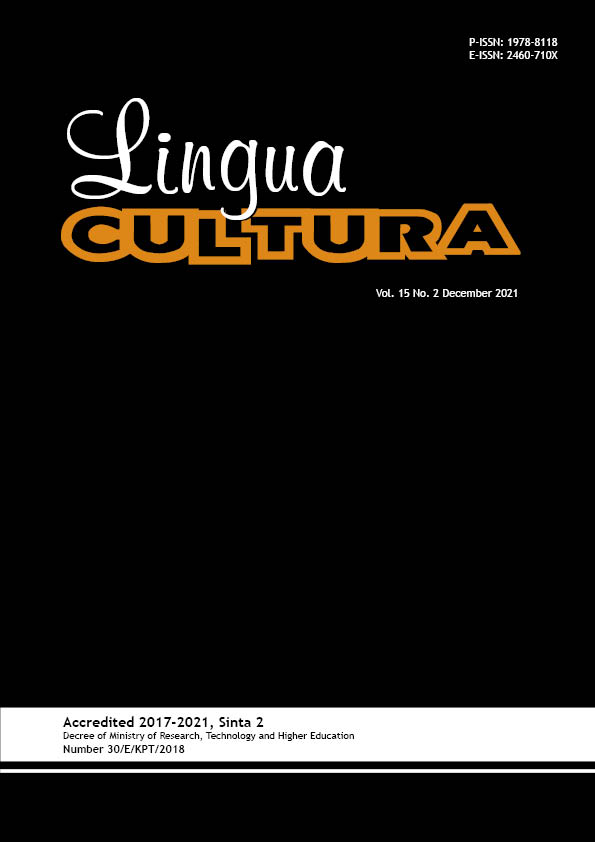Social Relation that Triggers the Use of Code-Switching in the Novel the Architecture of Love by Ika Natassa
DOI:
https://doi.org/10.21512/lc.v15i2.7328Keywords:
social relation, code switching, novel characters, novel narrativeAbstract
The research aimed to find out the influencing factors that caused the characters and the narrator in the novel ‘The Architecture of Love’ to do code-switching and discover how the social relation between the characters and the narrator affected the use of code-switching. Novels written by bilingual authors were frequently used as objects of analysis in code-switching research. However, most research only focused on the code-switching performed by the characters in the novels. Rarely had the attention been given to the authors or the narrators of the story. A descriptive text analysis method and library research were used to analyze the dialogues and narratives found in this novel. Results show that the reasons for most of the code switch used in the dialogues and narratives are the intentions of clarifying the speech content for the interlocutors and when talking about a particular topic. The social relation of the character shows that they treat each other as friends that have equal social status. A similar relation is also found between the writer and the readers. It can be implied that the social relation between the characters does affect the use of code-switching.
References
Adi, W. T. (2018). Code Sswitching in Critical Eleven novel. Metathesis: Journal of English Language, Literature, and Teaching, 2(1), 39-57. https://doi.org/10.31002/metathesis.v2i1.514.
Al Rousan, R., & Merghmi, K. (2019). A conversational analysis of Arabic-French code switching in Algerian TV talk shows. Jordan Journal of Modern Languages and Literatures, 11(3), 247-271.
Akhtar, S., Baig, F. Z., Aslam, M. Z., Khan, T., Tayyaba, S., & Iqbal, Z. (2020). Code-switching and identity: A sociolinguistic study of Hanif’s novel Our Lady of Alice Bhatti. International Journal of English Linguistics, 10(1), 364-371. https://doi.org/10.5539/ijel.v10n1p364.
Febryanti, N. K., Hadi, M. Z. P., & Hastuti, H. (2019). An analysis of code-switching used in ‘The Architecture of Love’ novel written by Ika Natassa. Humanitatis, 6(1), 109-118. https://doi.org/10.30812/humanitatis.v6i1.556.
Hartmann, S., Choudhury, M., & Bali, K. (2018). An integrated representation of linguistic and social functions of code-switching. Proceedings of LREC2018. Pp 1615-1622. Retrieved from http://www.lrec-conf.org/proceedings/lrec2018/pdf/392.pdf.
Holmes, J., & Wilson, N. (2017). An introduction to sociolinguistics (fifth edition). London: Routledge.
Husayn, A. M. (2020). Code-switching and the linguistic identity in Ilias Khoury’s Gate of the Sun. Al-Adab Journal, 132(1), 125-134.
Hutami, R. N. (2017). Types and speech functions of code-switching used by Keara in Antologi Rasa novel. Thesis. Yogyakarta: Sanata Dharma University.
Juniari, N. K. D., Ariyaningsih, N. N. D., & Jendra, I. M. I. I. (2021). Code switching in ‚Jika Kita Tidak Pernah Jadi Apa Apa’ novel. International Journal of Husocpument, 1(2), 45-51. https://doi.org/10.51715/husocpument.v1i2.29.
Lyakhovich, A. (2019). Patterns of Hausa-English code-switching in Jamila Danfajo’s novel Kukan so. Vestnik of Saint Petersburg University. Asian and African Studies, 11(3), 311-320. https://doi.org/10.21638/spbu13.2019.305.
Meilisa. (2013). Code switching and code mixing found in the novel ‚Supernova: Ksatria’, ‚Putri’, dan ‚Bintang Jatuh’ by Dewi Lestari. Jurnal Ilmiah Mahasiswa Fakultas Ilmu Budaya Universitas Brawijaya, 1(5), 5-10.
Mukherjee, S., & Mohanty, D. A. (2020). Role of code-switching and code-mixing in indigenous communicative contexts: A study of the god of small things. Rupkatha Journal on Interdisciplinary Studies in Humanities, 12(2), 1-11. https://doi.org/10.21659/rupkatha.v12n2.03.
Natassa, I. (2016). The architecture of love. Jakarta: Gramedia Pustaka Utama.
Poplack, S. (1980). Sometimes I start a sentence in English y termino en Español: Toward a typology of code-switching. Linguistics, 18(7-8), 581-618. https://doi.org/10.1515/ling.1980.18.7-8.581.
Sari, P. I. T., Malini, N. L. N. S., & Putra, I. K. S. (2017). Types and functions of code switching in Zalea’s “Crash Into You.†Humanis, 19(1), 102-109.
Saville-Troike, M., & Barto, K. (2016). Introducing second language acquisition. Cambridge: Cambridge University Press.
Weston, D., & Gardner-Chloros, P. (2015). Mind the gap: What code-switching in literature can teach us about code-switching. Language and Literature, 24(3), 194-212. https://doi.org/10.1177/0963947015585066.
Yusuf, Y. Q., Fata, I. A., & Chyntia, C. (2018). Types of Indonesian-English code-switching employed in a novel. Kasetsart Journal of Social Sciences, 41(1), 208-213. https://doi.org/10.1016/j.kjss.2018.02.004.
Downloads
Published
How to Cite
Issue
Section
License
Copyright (c) 2021 Clara Herlina Karjo, Fairuza Alyarizky

This work is licensed under a Creative Commons Attribution-ShareAlike 4.0 International License.
Authors who publish with this journal agree to the following terms:
a. Authors retain copyright and grant the journal right of first publication with the work simultaneously licensed under a Creative Commons Attribution License - Share Alike that allows others to share the work with an acknowledgment of the work's authorship and initial publication in this journal.
b. Authors are able to enter into separate, additional contractual arrangements for the non-exclusive distribution of the journal's published version of the work (e.g., post it to an institutional repository or publish it in a book), with an acknowledgment of its initial publication in this journal.
c. Authors are permitted and encouraged to post their work online (e.g., in institutional repositories or on their website) prior to and during the submission process, as it can lead to productive exchanges, as well as earlier and greater citation of published work.
USER RIGHTS
All articles published Open Access will be immediately and permanently free for everyone to read and download. We are continuously working with our author communities to select the best choice of license options, currently being defined for this journal as follows: Creative Commons Attribution-Share Alike (CC BY-SA)


















